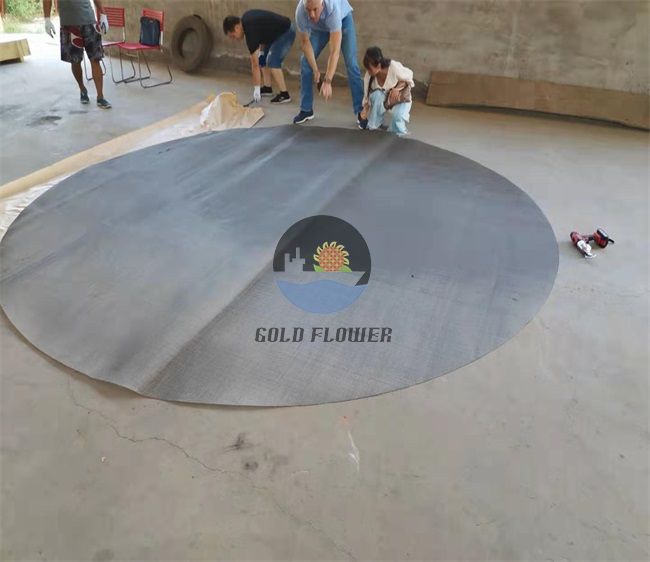The term ‘Mesh’ is used to describe the size of an abrasive particle. In some instances, such as with Aluminum Oxide Grit or Silicon Carbide Grit, a single number is used. This does not mean every particle in that product is exactly that size but rather than mesh size indicator is approximately the mean or average size of the range of particles in that grade. In other instances, such as with Walnut Shell Grit or Glass Beads, two numbers are used. This indicates that all of the particles in that grade of the product are within that range of mesh sizes.
Contained below is more detail about Mesh size, how that is related to the grit size, and what these terms mean as it relates to abrasive (and non-abrasive) products.
What is Mesh Size?
U.S. Mesh Size (or U.S. Sieve Size) is defined as the number of openings in one square inch of a screen. For example, a 36 mesh screen will have 36 openings while a 150 mesh screen will have 150 openings. Since the size of the screen (one square inch) is constant, the higher the mesh number the smaller the screen opening and the smaller the particle that will pass through. Generally, US Mesh is measured using screens down to 325 mesh (325 openings in one square inch).
Sometimes the mesh size of a product is noted with either a minus (-) or plus (+) sign. These signs indicate that the particles are either all smaller than (-) or all larger than (+) the mesh size. For example, a product identified as -100 mesh would contain only particles that passed through a 100 mesh screen. A +100 grade would contain particles that did not pass through a 100 mesh screen. When a grade of product is noted with a dash or a slash is indicates that the product has particle contained within the two mesh sizes. For example, a 30/70 or 30-70 grade would only have particles that are smaller than 30 mesh and larger than 70 mesh.
Mesh vs. Grit
The terms Mesh and Grit are often confused. The terms can be used interchangeably when referring to abrasive grit. A 60 mesh Aluminum Oxide can also correctly be termed a 60 grit Aluminum Oxide. In practical terms, identifying a specific abrasive product with the term 60 Mesh would normally indicate that the product has a median size of the openings on a 60 mesh screen. The term 60 Grit more accurately identifies the particle size distribution of the product but the difference in terminology is insignificant for industry purposes. See our blog post Mesh vs. Grit for more detail.
Mesh to Micron Conversion Chart
The chart below shows the approximate size in inches and microns for various mesh sizes. These values are generally accepted as accurate but are approximates because the thickness of the wire used to make a specific screen will vary the number of openings in the one square inch. A micron is one-millionth of a meter or one-twenty-five thousandths of an inch. Most grades below 325 mesh are indicated by the micron size as these sizes are not manufactured using screens.
US Mesh |
Micron |
Inches |
|---|---|---|
| 4 | 4,750 um | 0.187 |
| 5 | 4,000 um | 0.157 |
| 6 | 3,350 um | 0.132 |
| 7 | 2,800 um | 0.111 |
| 8 | 2,360 um | 0.0937 |
| 10 | 2,000 um | 0.0787 |
| 12 | 1,700 um | 0.0661 |
| 14 | 1,400 um | 0.0555 |
| 16 | 1,200 um | 0.0473 |
| 18 | 1,000 um | 0.0394 |
| 20 | 850 um | 0.0331 |
| 24 | 690 um | 0.027 |
| 30 | 560 um | 0.022 |
| 36 | 485 um | 0.019 |
| 40 | 425 um | 0.016 |
| 46 | 355 um | 0.014 |
| 54 | 305 um | 0.012 |
| 60 | 250 um | 0.01 |
| 70 | 210 um | 0.0083 |
| 80 | 165 um | 0.0065 |
| 90 | 145 um | 0.0057 |
| 100 | 149 um | 0.0059 |
| 120 | 125 um | 0.0049 |
| 140 | 105 um | 0.0041 |
| 150 | 89 um | 0.0035 |
| 170 | 88 um | 0.0031 |
| 180 | 76 um | 0.003 |
| 200 | 75 um | 0.0029 |
| 220 | 63 um | 0.0025 |
| 240 | 53 um | 0.002 |
| 280 | 44 um | 0.0015 |
| 320 | 36 um | 0.0012 |
| 400 | 23 um | 0.00087 |
| 500 | 19 um | 0.00075 |
| 600 | 16 um | 0.00063 |
| 800 | 12 um | 0.00047 |
| 1,000 | 9 um | 0.00028 |
| 1,200 | 6 um | 0.00024 |


